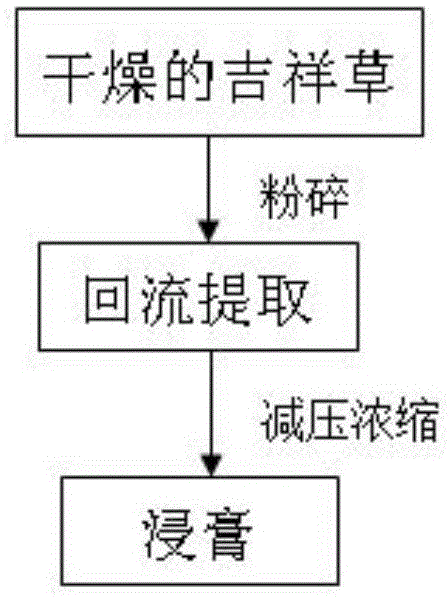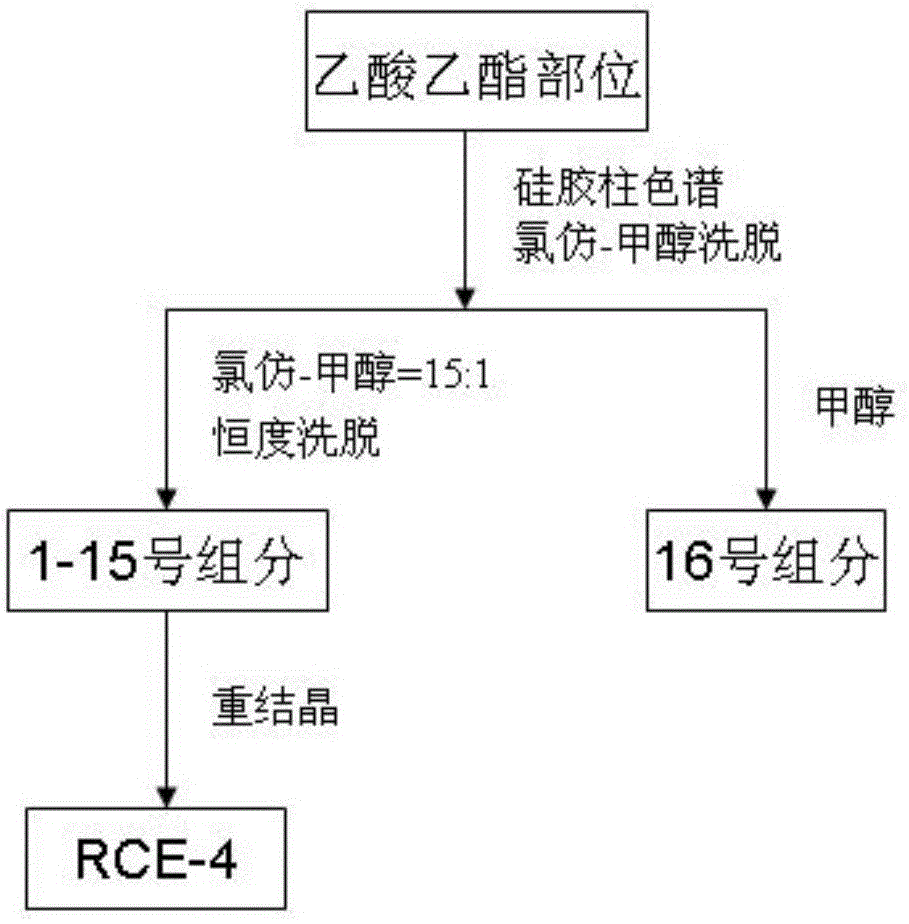Application of steroid saponin RCE-4 in preparation of medicines for preventing or treating tumors
A technology of RCE-4 and steroidal saponins, applied in the field of medicine, can solve problems such as toxic side effects and high costs
- Summary
- Abstract
- Description
- Claims
- Application Information
AI Technical Summary
Problems solved by technology
Method used
Image
Examples
Embodiment 1
[0054] RCE-4, a compound with anti-tumor activity in Auspicious Grass, is specifically prepared by the following method:
[0055] 1) Pretreatment of auspicious grass
[0056] Auspicious grass rhizomes were washed and dried in the sun, and 0.005 kg was taken for preservation, and the rest was dried in a constant temperature blast box at 48°C until constant weight, net weight 4.0 kg.
[0057] 2) Auspicious grass reflux extraction
[0058] Cut the sample into small pieces, use 95% ethanol as solvent, and extract under normal pressure at 65°C. After the extract is filtered, it is concentrated with a rotary evaporator at 55°C, and then evaporated to dryness in a fume hood until there is no alcohol smell. , to obtain a deep extract, weighed to obtain 1.4kg of extract (see figure 1 ).
[0059] 3) Extraction of Auspicious Grass Extract
[0060] Add 1 liter of distilled water to dissolve the extract obtained in 2) above, and extract with extractant sherwood oil, ethyl acetate, and ...
experiment example 1
[0083] The application of the RCE-4 obtained in Example 1 of the present invention for anti-liver cancer at the cellular level will be described below in conjunction with specific experimental examples.
[0084] Effect of RCE-4 on normal cells monkey kidney cells (marc-145), canine kidney cells (MDCK) and human liver cancer cell H 22 and the cytotoxic activity of HepG2.
[0085] experiment method
[0086] 1) Cell culture
[0087] marc-145 and MDCK cells were cultured in DMEM-F12 medium in CO 2 5% CO in the incubator 2 , 37°C and saturated humidity. When the cell monolayer grows to 80%, it is digested with 0.25% trypsin containing EDTA and passaged.
[0088] h 22 and HepG2 human liver cancer cells were cultured in RPMI-1640 medium in CO 2 Cultivate in an incubator with 5% CO2, 37°C and saturated humidity. When the cell monolayer grows to 80%, it is digested with 0.25% trypsin and subcultured.
[0089] 2) 3-(4,5-dimethylthiazole-2)-2,5-diphenyltetrazolium bromide (MTT) ...
experiment example 2
[0099] The application of RCE-4 in Example 1 of the present invention in anti-hepatoma at the animal level will be described below in conjunction with specific examples.
[0100] RCE-4 for H 22 Antitumor activity in tumor-bearing mice.
[0101] RCE-4 for H 22 Anti-tumor test in mice with ascites tumor
[0102] experiment method
[0103] 1) Experimental materials
[0104] Female Kunming mice (18-22 g) were purchased from the Experimental Animal Center of China Three Gorges University, animal production license number: SCXK (E) 2011-0012. The H22 tumor cell line was purchased from the Chinese Type Culture Collection Center of Wuhan University, and was preserved by the Hubei Provincial Key Laboratory of Natural Product Research and Utilization of Three Gorges University.
[0105] 2) Establishment of cell culture and animal model
[0106] h 22 Cells were cultured in 10% newborn calf serum, 10 5 U / L penicillin, 100 mg / L streptomycin in RPMI-1640 medium, placed at 37 ° C, CO...
PUM
 Login to View More
Login to View More Abstract
Description
Claims
Application Information
 Login to View More
Login to View More - R&D
- Intellectual Property
- Life Sciences
- Materials
- Tech Scout
- Unparalleled Data Quality
- Higher Quality Content
- 60% Fewer Hallucinations
Browse by: Latest US Patents, China's latest patents, Technical Efficacy Thesaurus, Application Domain, Technology Topic, Popular Technical Reports.
© 2025 PatSnap. All rights reserved.Legal|Privacy policy|Modern Slavery Act Transparency Statement|Sitemap|About US| Contact US: help@patsnap.com



